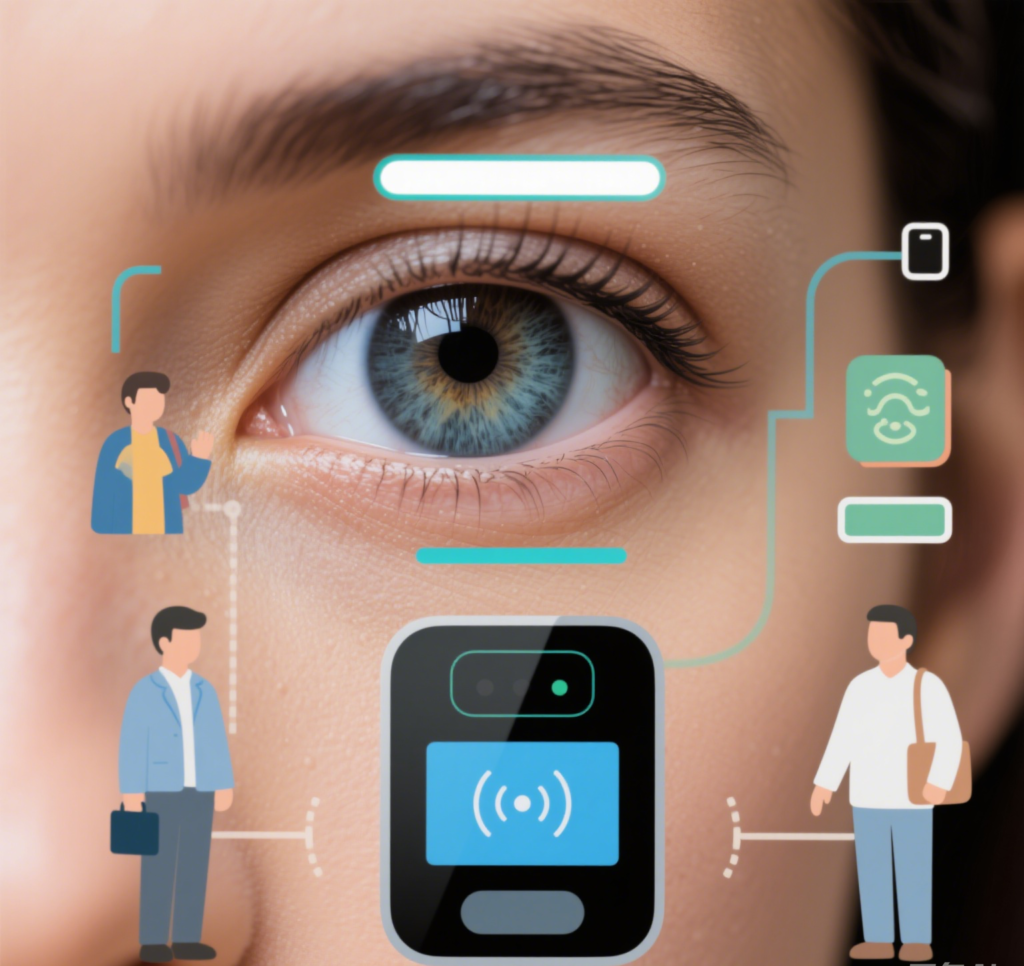Applications of Iris Recognition
1.Enhanced Security Systems
Airports like Dubai International and Schiphol in the Netherlands utilize advanced iris scanning technology for rapid and secure passenger verification, significantly speeding up immigration processes while ensuring high levels of accuracy and security in identity authentication.
Tech giants employ iris-based authentication to protect sensitive data centers, ensuring only authorized personnel gain access. This advanced biometric method offers high accuracy, resistance to spoofing, and enhances overall security by safeguarding critical infrastructure from unauthorized intrusion or data breaches.
Agencies leverage iris databases to identify suspects with over 99% accuracy, enabling fast and reliable criminal identification. This high-precision biometric technology helps law enforcement enhance investigation efficiency, reduce false positives, and strengthen public safety through accurate identity verification.
2.Healthcare Innovation
Hospitals in India and Kenya use iris scans to prevent medical record mismatches, ensuring accurate patient identification. This technology enhances healthcare efficiency, reduces errors in treatment, and safeguards patient data by linking individuals to their records through a secure and tamper-proof biometric method.
Smart systems use iris recognition to authenticate patients before releasing controlled medications, ensuring that only authorized individuals receive prescriptions. This enhances safety, prevents drug misuse, and maintains accurate medical dispensing records in hospitals, clinics, and pharmacies.
3.Financial Technology
Banks like HSBC and Citigroup are piloting iris authentication for app logins, offering customers a fast, secure, and password-free way to access their accounts. This advanced biometric solution enhances user convenience while significantly reducing the risk of fraud and unauthorized access.
Biometric ATMs in Japan and Brazil use iris recognition to eliminate the risks of PIN fraud. By replacing traditional PIN codes with secure iris scans, these machines ensure safer transactions, reduce identity theft, and provide users with a more convenient and fraud-resistant banking experience.

Technological Advancements Driving Development
1.AI-Powered Iris Recognition
Deep Learning Algorithms
Enhancing pattern recognition speed by 40%, iris recognition technology has significantly improved the efficiency of biometric systems. By leveraging advanced algorithms and high-resolution imaging, iris scanners can rapidly identify individuals with greater accuracy and speed, making them ideal for high-security environments. This boost in processing power ensures quicker access to restricted areas, faster transaction times, and improved overall system performance across various industries, from banking to healthcare and law enforcement.
Adaptive Systems
AI-powered iris recognition technology adjusts seamlessly for various factors, such as aging irises and changing environmental conditions like lighting. It uses advanced algorithms to account for the natural changes in the iris over time, ensuring consistent accuracy and reliability. Whether in bright sunlight or dimly lit areas, this system continues to provide highly secure and precise identification, making it an ideal solution for a wide range of access control and security applications.
2.IoT Integration
Smart Devices
Iris recognition technology is increasingly integrated into everyday devices like smartphones, including the Samsung Galaxy series, and smart locks. These devices utilize advanced iris scanning sensors to offer a secure and convenient way to authenticate users. By capturing the unique patterns in the iris, they provide highly accurate identification, reducing the risks of unauthorized access. Whether for mobile security or smart home solutions, iris recognition ensures seamless, contactless, and reliable protection for personal data and physical spaces.
Wearables
Iris recognition technology is being integrated into AR/VR headsets to enhance personalized user experiences. By utilizing iris tracking, these devices can precisely map an individual’s eye patterns, allowing for more accurate adjustments in visual settings, comfort levels, and even access control within virtual environments. This ensures a more immersive and tailored experience, as the system adapts to each user’s unique iris features. Additionally, it strengthens security, making these headsets more secure and user-friendly.
3.Multimodal Biometrics
Иристі тану is increasingly being combined with other biometric technologies, such as facial recognition or voice authentication, to enhance security and reliability. For example, Apple’s “Face ID + Iris” patent (2023) aims to create a fail-safe security system by integrating multiple authentication methods. The unique patterns of the iris, which remain stable over time, provide a high level of accuracy. When combined with facial or voice recognition, this dual-layer approach ensures more secure device access, minimizing the risk of unauthorized entry and improving overall user experience, even in challenging conditions.
Challenges and Ethical Considerations
1.Privacy Concerns
Storage of biometric data, such as iris scans, raises GDPR compliance concerns due to the sensitive nature of the information. Organizations must implement strict data protection measures, ensure informed consent, and follow legal guidelines to prevent misuse and safeguard user privacy.
2.Cost Barriers
Iris recognition offers high security, but the cost of high-end scanners remains a challenge for small businesses. These devices often require advanced hardware and software, making them less accessible for organizations with limited budgets, despite their reliability and accuracy in identity verification.
3.Accessibility
Variations in iris pigmentation, especially in darker irises, can affect recognition accuracy. To ensure fairness and reliability, iris recognition systems must incorporate algorithm bias mitigation, allowing consistent performance across different eye colors and ethnic backgrounds in diverse user populations.
The Future of Iris Recognition
1.Contactless Solutions
Post-pandemic, the demand for hygienic, contactless authentication has surged, making iris recognition more attractive. Its ability to verify identity without physical contact reduces the risk of germ transmission, offering a secure and sanitary solution for access control in public and private spaces.
2.Quantum Computing
Iris recognition systems rely on ultra-secure encryption to protect biometric databases. This ensures that sensitive iris data remains safe from breaches or unauthorized access, maintaining user privacy and reinforcing trust in high-security applications like finance, healthcare, and government systems.
3.Ethical AI Frameworks
Iris recognition systems are increasingly adopting transparent algorithms to address concerns about bias and privacy. By ensuring fairness in data processing and offering clearer insights into decision-making, these systems build user trust while complying with global data protection standards.
Қорытынды
From securing smart cities to personalizing healthcare, iris recognition is redefining how we verify identity. As AI and IoT continue to advance, this technology will become faster, more accessible, and deeply integrated into daily life. However, balancing innovation with ethical responsibility remains critical to ensuring trust in biometric systems.
Жиі қойылатын сұрақтар
Iris recognition analyzes unique eye patterns with 99.99% accuracy (NIST), surpassing fingerprints and facial recognition.
It uses non-contact near-infrared scanning and encrypted templates, complying with ISO safety standards.
Multispectral imaging adapts to dark irises; severe eye conditions may require combining with other biometrics.
Healthcare (patient ID), fintech (PIN-free ATMs), and smart cities (public security) lead adoption.
Data is stored as unreadable encrypted codes, with quantum encryption enhancing future security.
It replaces passwords in mobile devices but pairs with behavioral biometrics for high-security needs.
GDPR and CCPA enforce data anonymity and restrict mass surveillance risks.
AI edge computing speeds scans, quantum encryption secures data, and global ethics frameworks evolve.





